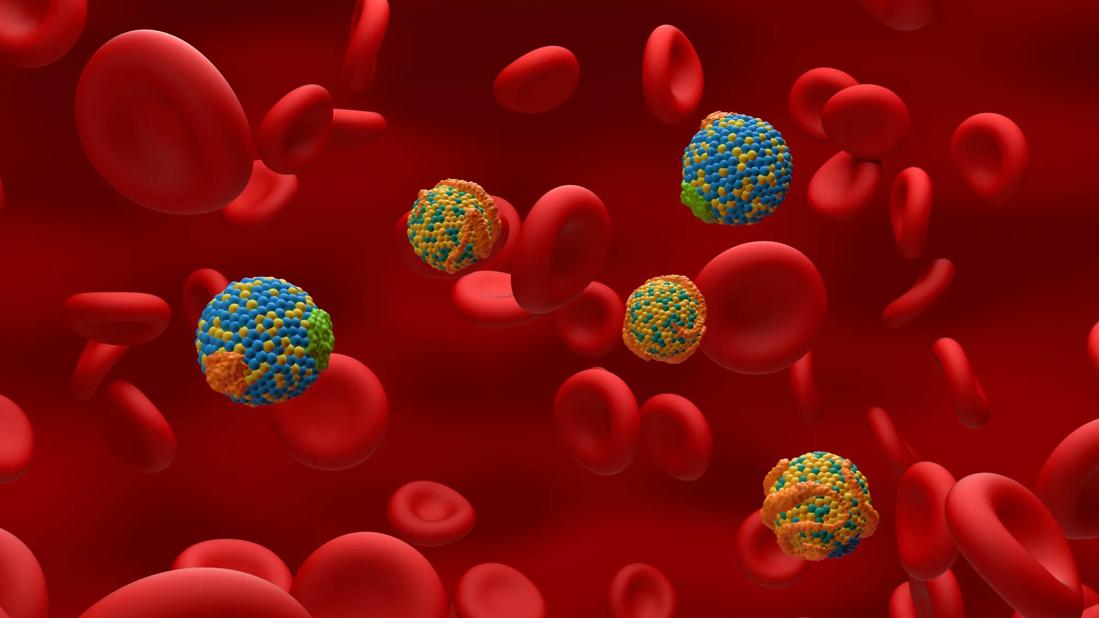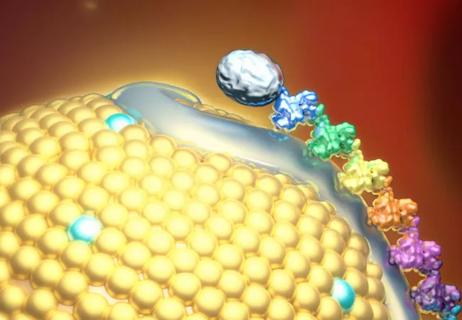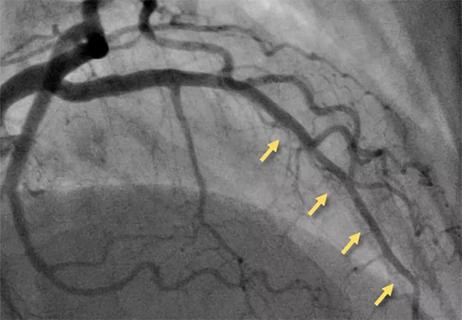Undetectable levels achieved for nearly nine months in phase 1 trial

A novel short-interfering RNA (siRNA) therapy known as lepodisiran reduced levels of lipoprotein(a) (Lp(a)) below the lowest limit of quantitation for nearly nine months in a first-in-human phase 1 trial. The study, presented by Steven Nissen, MD, in a late-breaking science session at the American Heart Association Scientific Sessions 2023 and simultaneously published online in JAMA, represents the most potent and durable Lp(a)-lowering effect with any therapy reported to date.
Advertisement
Cleveland Clinic is a non-profit academic medical center. Advertising on our site helps support our mission. We do not endorse non-Cleveland Clinic products or services. Policy
“A single dose of lepodisiran lowered Lp(a) to a level undetectable by the standard assay from day 29 to day 281 following administration, and to a level 94% below baseline at the end of the 48-week study,” says Dr. Nissen, Chief Academic Officer of Cleveland Clinic’s Heart, Vascular & Thoracic Institute. “This is an unprecedented degree and duration of Lp(a) reduction with an siRNA. Lepodisiran appears to be a safe and incredibly effective way to lower lipoprotein(a) that can likely be given once or twice a year, like a vaccine. Elevated lipoprotein(a) is currently an untreatable risk factor for cardiovascular disease, so the implications of these effects could be significant.”
Lipoprotein(a) is a variant of low-density lipoprotein that contains an atherogenic component, apolipoprotein B100, and a prothrombotic component, apolipoprotein(a). Approximately 20% of the population has elevated blood levels of Lp(a), which are associated with a heightened risk — and often an accelerated course — of atherosclerotic cardiovascular disease and aortic stenosis.
“Elevated Lp(a) can nearly double the risk of atherosclerotic cardiovascular disease and aortic stenosis, and it tends to lead to disease at a younger age,” Dr. Nissen notes.
Elevated blood Lp(a) levels are due to genetic variations in the LPA gene that encodes apolipoprotein(a) and cannot be reduced by available lipid-lowering therapies or lifestyle modifications. “It’s a currently untreatable disorder that puts an estimated 64 million people in the U.S. at increased risk of cardiovascular morbidity and mortality,” Dr. Nissen observes. “It’s one of the very last untreatable frontiers of cardiovascular risk.”
Advertisement
He notes that because elevated Lp(a) is genetically determined, the only way to prevent its harmful effects is to silence the LPA gene. Clinical researchers are trying to do that with novel medications that degrade the messenger RNA that codes for apolipoprotein(a), thereby reducing translation of the LPA gene.
Strategies for doing this — known as nucleic acid therapeutics — involve use of an antisense oligonucleotide or one of several siRNA drugs in development, including lepodisiran. siRNA therapies are small pieces of double-stranded RNA connected to N-acetyl-galactosamine (GalNAc), a sugar that binds to receptors in hepatocytes. This concentrates the siRNA in the liver, where it blocks the synthesis of apolipoprotein(a) required for formation of Lp(a).
The present phase 1 study was designed to assess the safety, pharmacokinetics and efficacy of lepodisiran given at one of six dose levels (4 mg, 12 mg, 32 mg, 96 mg, 304 mg, 608 mg) relative to placebo among 48 adults with an Lp(a) concentration ≥75 nmol/L but with no known cardiovascular disease.
Six participants were randomized to each of the lepodisiran doses, and 12 were randomized to placebo. Study drug was given as a single subcutaneous injection, after which patients were followed via regular office visits and laboratory studies for 48 weeks. The study was conducted at five clinical research sites in the U.S. and Singapore.
Participants were 65% male and had a mean age of 47 years. The cohort was 48% Asian, 33% white and 15% Black. Participants’ median baseline Lp(a) level was 113 nmol/L (interquartile range [IQR], 82 to 151).
Advertisement
On the study’s primary endpoint of safety, no serious treatment-related adverse events occurred, and lepodisiran was well tolerated, with adverse events being infrequent and generally comparable across the placebo and lepodisiran dose groups. Mild injection-site reactions were the most common adverse event.
Plasma levels of lepodisiran were dose-dependent and peaked within 12 hours of injection, disappearing within 48 hours of administration in all dose groups. “This indicates that the drug rapidly gets out of the circulation and acts where it is needed — in the liver cells where Lp(a) is formed,” Dr. Nissen notes. “This is important from a safety perspective, because if the drug is not circulating for long, it won’t do anything in other tissues where it’s not needed.”
On the secondary outcome of maximal percentage change in Lp(a) serum concentrations from baseline, results were as follows (values are median followed by IQR):
The reductions in Lp(a) were long-lasting for the highest doses, with a >90% reduction in median levels from day 29 to day 225 for the 304-mg dose and with median concentrations below the lower limit of quantification from day 29 to day 281 for the 608-mg dose.
“What we’re seeing is essentially a drug that can likely be given once or twice a year and can eliminate lipoprotein(a) from the circulation,” Dr. Nissen says. He notes that the duration of >90% Lp(a) reduction with the highest doses of lepodisiran is greater than that seen with other nucleic acid therapeutics studied to date. The reasons for this are not certain, Dr. Nissen says.
Advertisement
The investigators acknowledge that safety cannot be comprehensively assessed in a single-dose trial of this size and duration, and that the minimum Lp(a) entry criterion was moderate, at 75 nmol/L. These limitations will be addressed in a larger, multidose phase 2 trial of lepodisiran that’s now underway (NCT05565742). A phase 3 trial is also being planned.
These trials put lepodisiran in the company of several other nucleic acid therapeutics in development to reduce Lp(a) levels by targeting hepatic production of apolipoprotein(a):
These studies should help determine whether this method of Lp(a) lowering reduces major adverse cardiovascular events in individuals with Lp(a) elevation, as well as the magnitude of Lp(a) reduction needed to yield event reduction. “This is a race to get the best drug with the greatest efficacy for the longest duration with the most convenience for patients,” Dr. Nissen says.
The race can’t be completed soon enough for the estimated 1.4 billion people worldwide with elevated Lp(a), according to Luke Laffin, MD, staff cardiologist in Cleveland Clinic’s Section of Preventive Cardiology. “Lp(a) is an important cause of early and aggressive coronary disease, particularly in individuals without other traditional cardiovascular risk factors,” says Dr. Laffin. “We have no FDA-approved therapies to reduce Lp(a) and cardiac risk, so this has been a substantial challenge that we’ve been unable to treat. The durable lowering of Lp(a) with lepodisiran in this study was quite impressive. We eagerly look forward to results from ongoing and future trials of this and the other nucleic acid therapeutics.”
Advertisement
Advertisement

Yet 21.4% of tested individuals had Lp(a) elevation

Small interfering RNA lowered lipoprotein(a) by 94% during six-month follow-up after a single dose

Phase 2 trial of zerlasiran yields first demonstration of longer effect with each dose of an siRNA

It's time to increase testing for this major cardiovascular risk factor in advance of new therapies

First-in-human phase 1 trial induced loss of function in gene that codes for ANGPTL3

Proteins related to altered immune response are potential biomarkers of the rare AD variant

Resourceful approaches to the care of patients with microvascular disease and elevated Lp(a)

Why Cleveland Clinic is launching its cardioimmunology center